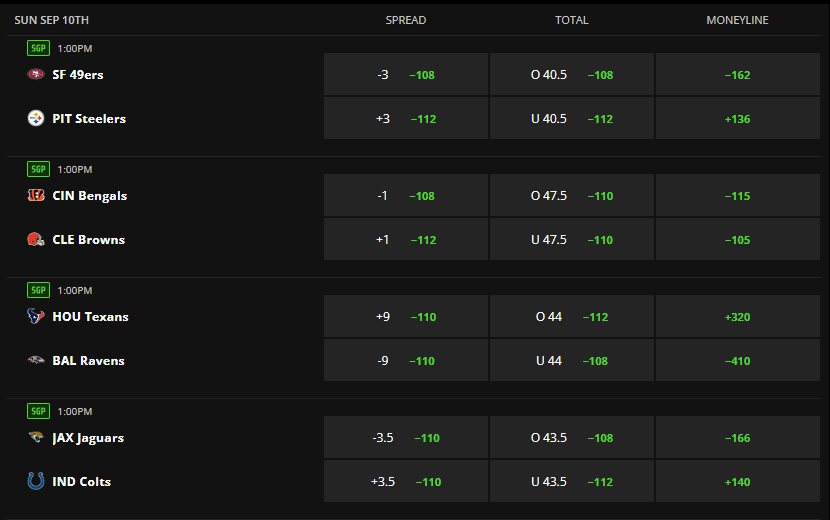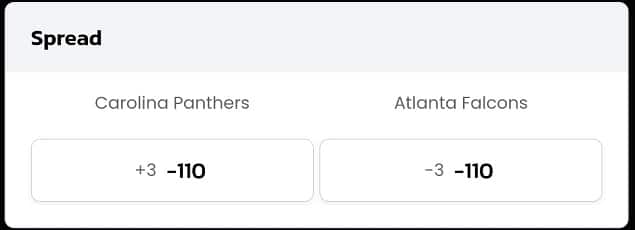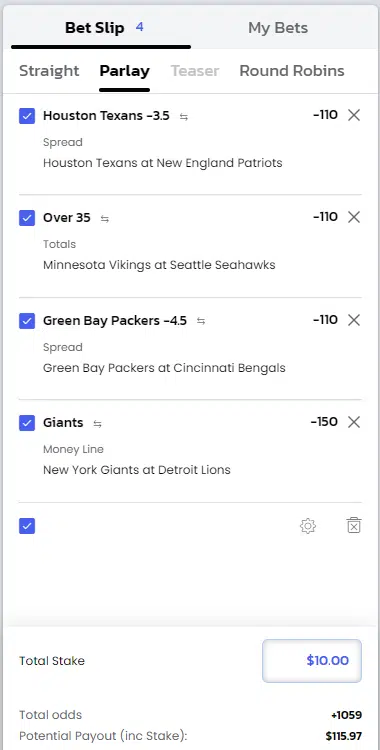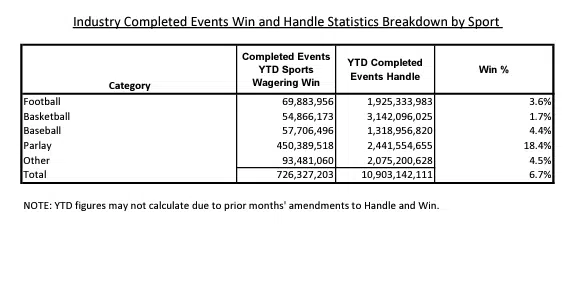On this page, sports betting veteran Rob Dellafave explains how to bet on the NFL in simple terms but with an emphasis on cultivating a professional bettor’s mindset from the beginning. Unlike other NFL betting guides, this one shares hard-won lessons and veteran insights that will benefit absolute newbies and experienced bettors alike. Read on to learn about the various types of NFL wagers, how to interpret the odds, what the vigorish means, and how to think like a professional.
Where To Bet On NFL Games
 Play $5, Get $50 in LineupsPrizePicks Promo Code: BUSA
$50 provided as promo funds, only for use on PrizePicks. Promo funds provided under this promotion must be played within 90 days of receipt or shall become null and void at PrizePicks’ discretion. Promo ends 12/31/25. Void where prohibited. If you or someone you know has a gaming problem, get help. Crisis services and responsible gaming counseling can be accessed by calling 1-800-426-2537 or online at www.ncpgambling.org. 18+ in most eligible jurisdictions, but other age and eligibility restrictions may apply. Valid only in jurisdictions where PrizePicks operates. See prizepicks.com/terms for full PrizePicks terms of service.
Play $5, Get $50 in LineupsPrizePicks Promo Code: BUSA
$50 provided as promo funds, only for use on PrizePicks. Promo funds provided under this promotion must be played within 90 days of receipt or shall become null and void at PrizePicks’ discretion. Promo ends 12/31/25. Void where prohibited. If you or someone you know has a gaming problem, get help. Crisis services and responsible gaming counseling can be accessed by calling 1-800-426-2537 or online at www.ncpgambling.org. 18+ in most eligible jurisdictions, but other age and eligibility restrictions may apply. Valid only in jurisdictions where PrizePicks operates. See prizepicks.com/terms for full PrizePicks terms of service.
*The options available in your state are fantasy pick’em apps and social sportsbooks, not technically sports betting.
NFL betting was already popular before PASPA was overturned in early 2018, but now that more than half the country has easy access to legal sports betting, it has reached a fever pitch. These days, putting some action on the NFL has become as integral a part of American culture as watching the games themselves.
Online sportsbooks have responded to this demand in kind, by vastly increasing the number and variety of available NFL wagers. No longer are bettors confined to simple wagers like “betting against the spread” or picking winners. Legal NFL betting sites now post hundreds of lines for even the most meaningless mismatches.
For new bettors, the sheer immensity of NFL betting menus can be overwhelming, and can lead them to place wagers they don’t fully understand.
So, if you’re unfamiliar with terms like player props, same game parlays, negative odds, and round robins, you’ve come to the right place. In this guide, BettingUSA takes an in-depth look at the most common ways to bet on NFL games and explains the pros and cons of each betting format. Once you have a solid understanding of the fundamentals, be sure to see BettingUSA’s NFL betting tips and strategy guides:
- NFL Betting Strategies for Beginners: 12 Tips for Success
- NFL Public Betting Explained and Myths Debunked
How to Read and Understand NFL Odds
Before placing a wager, it’s crucial that bettors have a basic understanding of NFL odds.
US sportsbooks use American Odds by default, which is probably the least intuitive odds format but still relatively easy to grasp.
In short, American Odds are displayed as either negative odds or positive odds:
- Negative odds (-) indicate a favorite, and are interpreted as “Bet [-odds] to win $100.” Therefore if the odds are -400, bettors must bet $400 to win $100. The larger the negative odds, the bigger the favorite. I.e. A bet at -1000 is more likely to win than one at -200.
- Positive odds (+) indicate an underdog, and are interpreted as “Bet $100 to win [odds].” At +200 odds, bettors would win $200 for each $100 wagered. As the positive odds increase, the likelihood of a winning outcome decreases. I.e. A bet at +1000 is less likely to win than one at +200, but it pays significantly more.
The original stake is always returned on winning cash wagers, so a $100 bet on the NY Giants at +300 would return $300 in winnings and the original $100 stake, for a total of $400. Of course, not all wagers will be exactly $100, but $100 is the standard unit for American Odds.
Most US sportsbooks allow players to display NFL odds in different formats, such as decimal odds and fractional odds. These formats may be a bit easier to interpret, especially for those who come from a European or horse racing background.
How NFL Vigorish Works
New bettors may wonder why NFL point spreads are often listed at -110/-110, which suggests that both teams are favored. That’s where the house edge comes in. In this case, the fair odds are actually +100/+100, which is a coin flip. However, sportsbooks generate revenue by levying a tax on all wagers called vigorish. So instead of paying bettors even money on a bet with a 50% probability, they pay $100 per $110 wagered.
Look at it this way. A bet with -110 odds is supposed to win 52.38% of the time. If a sportsbook posts -110/-110 spreads, the sum of probabilities is 104.96%, which feels off because probabilities are always supposed to total 100%. The 4.76% is called the overround and is essentially the house’s profit margin.
For a more thorough explanation, BettingUSA has a complete guide on American Odds and vigorish.
Popular NFL Bets
It’s become a tradition for online sportsbooks to display three bets on their NFL betting markets home page: Point Spreads, Moneylines, and Totals. These are the most popular NFL bets and a good place for bettors to start their wagering ventures, as they’re generally considered simple and safe bets.
Here’s how DraftKings Sportsbook displays the “Big Three.” Other sports betting sites display them in almost exactly the same way:
Notice that the Big Three are shown for all upcoming games, making it super convenient to scour betting lines.
NFL Moneylines: Betting On A Winner
The NFL moneyline is the most straightforward bet in football. Bettors select a team, and if that team wins, they’re paid out at the listed odds.
Pros
- Straightforward, easy-to-understand bet
- Low-to-moderate risk
- Potentially decent payouts
Cons
- Highly efficient market — tough to find edges
- Payouts on heavy favorites are mediocre
- Not always engaging
With moneylines, there are only two numbers to interpret, the American odds of the home team and the away team. For instance:
- Tampa Bay Buccaneers: +220
- Minnesota Vikings: -270
In this case, the Vikings are a fairly large favorite, with an implied probability of nearly 73%. A $270 bet would return $370 total. On the other hand, a $100 bet on the underdog Bucs would yield $320.
The beauty of the NFL is that there’s not a huge skill differential between the best and worst teams. After all, the league is comprised entirely of pro athletes playing at an elite level. It’s pretty rare for a team to be more than a -400 (80%) moneyline favorite. Likewise, underdogs usually don’t go off at odds longer than +400.
Expert Tip: A -400 moneyline favorite is expected to win by about 9 points.
The main drawback of NFL moneyline betting is that it’s a highly efficient market, and finding an edge is near impossible. NFL moneylines attract so much betting volume that sportsbooks are petrified of making mistakes. Even if they do flub up, the sharps will hammer lines into place at low limits before they’re offered in the US.
In addition, the payouts on betting heavy favorites aren’t terrific, and underdog bettors will incur some wild bankroll swings. Again, this is less of a problem in the NFL than in other sports. Finally, moneyline wagers aren’t always engaging, as teams that get out to a huge early lead effectively ruin the fun.
Yet, all this is offset by the simplicity of betting moneylines and their extremely low house edge, which is often lower than point spreads (<4.5%). A good place for NFL bettors to start.
NFL Point Spreads: The Great Equalizer
The NFL point spread is without question the most popular football bet. It’s so popular that it’s even developed its own slang. When bettors talk about “betting against the spread,” “ATS,” or “minus the points,” they’re referring to the point spread.
In short, the point spread seeks to convert a game into an even matchup, and this is accomplished by the underdog “getting” points and the favorite “giving” points.
Pros
- Simple two-way wager
- Reliably wins approximately 50% of the time
- Low risk, low vigorish
Cons
- Extremely efficient market
- Less than even money payouts
- A bit harder to grasp than moneylines
With NFL point spreads, there are two numbers to consider. The first is the spread, and the second is the odds. Consider the following example from BetMGM Sportsbook:
Notice the +3 associated with the Panthers. This means that Carolina is getting 3 points. Therefore if they win the game or lose by less than a field goal, the bet’s a winner. Likewise, the Falcons are giving 3 points (-3) and must win by more than a field goal for wagers to be graded winners. If the Falcons win by exactly 3 points, then the bet is a push.
Point spreads always parallel one another. If one team gets X points, the other gives X points.
The point spread is often referred to as a great equalizer or neutralizer because it levels the playing field. Its impact is evident in the odds. For instance, in the above example, the -110/-110 odds reflect a perfectly even matchup. Sportsbooks can’t always perfectly balance every variable, which is why bettors will sometimes see point spread odds like -115/-105 or -120/+100. More commonly, sportsbooks will leave the odds alone, and just move the spread a half-point or more.
Expert Tip: Bettors will notice that most spreads hover around 3 or 7 points. That’s because these key numbers are the most common margins of victory in the NFL, followed by 6 and 10.
Due to their overwhelming popularity, NFL points spreads are the most efficient betting market. Sadly, trying to beat them is mostly a fool’s errand. However, the vigorish on these wagers is only about 4.5%, and they’re relatively low risk, so bettors that take advantage of promos and keep their wagers in check should be able to at least break near even over the course of a season.
NFL Totals: Going Over Or Under
NFL totals are similar to point spreads in that the odds are roughly the same on both sides. The main difference is that instead of betting on the game outcome, they’re betting on whether the total number of points scored will be “Over” or “Under” a specific amount.
Pros
- Very straightforward bet
- Low vigorish
- Low risk
Cons
- Highly efficient market
- No big payouts
- Once the total goes over, it’s no longer engaging
Take a look at the example below:
Notice that both sides of the wager have the same odds, and the winner of the game is irrelevant. All that matters is if the score goes over or under 43.5 points. A bet on the over hits if the teams combine for 44+ points (i.e. 28-24), and the under hits when the total is less than 44 (i.e. 21-17).
Unlike other sports like soccer, the overtime period does factor into NFL totals. So if the teams end up tied in regulation at 21-21, but the final score is 24-21, the total is 45. Using the example above, the over wins.
In most cases the total ends in .5. Same with point spreads. The half-point is called the “hook” and is generally added to avoid pushes.
Like point spreads, totals are generally low-risk bets with a low house edge. They’re not quite as certain as point spreads, but still efficient enough that the average bettor cannot gain a meaningful edge. It is worth noting that some online sportsbooks will offer point spreads and totals at -105/-105, although this is becoming rarer.
Expert Tip: If a point spread or total is listed at shorter odds than -110/-110 (i.e. -115/-115 or -120/-110) don’t bet it, it’s not a good price.
Totals are usually fairly engaging bets that can generate real nail-biting drama, even if the game is a blowout. However, engagement drops to zero once the game goes over, which could happen as early as the 2nd or 3rd quarter.
Alternatives to Popular NFL Wagers
Once bettors get familiar with moneylines, point spreads, and totals they can easily transition to bets that are derived from these wagers. Specifically, they can look into betting alternative lines and derivatives.
NFL Alternative Lines: Buying and Selling Points
When bettors talk about buying and selling points, what they’re really referencing is alternative lines. As the name implies, alternative lines in the NFL are a range of point spreads and totals that differ from the main line.
Pros
- Flexible, simple bets
- Less efficient market
- Bettors can control their risk
Cons
- Higher vigorish than main markets
- Difficult to calculate expected value
For instance, assume that the Eagles are playing the Patriots, and the Eagles are listed at -4.5. A willing sportsbook will offer alternative spreads in 0.5 increments. The range will vary by the sportsbook, with the most confident books offering spreads that deviate by two touchdowns in either direction from the point spread. In this example, that would lead to alternative lines from Eagles -18.5 to +9.5.
Likewise, alternative totals can drift up to 14 points above or below the even money O/U. So, if the Over/Under is 38.5, odds may be offered from 24.5 to 52.5, all in half-point increments. That’s a lot of options.
Obviously, moving the line has an impact on the odds. In the previous example, a bet on the Eagles at -4.5 is listed at standard -110 odds. If bettors believe that the Eagles will win by more than a touchdown, they can move the line to -7.5 and get paid at +140 odds if Philly covers. On the flip side, moving the line to Eagles -1.5 results in much shorter odds, just -185.
It’s worth noting that not all points are created equal. If players move a spread down from -3.5 to -2.5 they’re going to pay a lot more than if the line was altered from -5 to -4. This again has to do with the nature of NFL scoring, which favors certain key numbers like 3, 6, and 7. The same logic applies to alternative totals, albeit to a much lesser degree.
The idea that bettors should never buy or sell points is a fallacy. While it is true that the vigorish on alternative lines is higher than on primary lines (the house edge is usually about 1-2% higher), alternative markets are innately less certain. Think of it this way: Is it easier for sportsbooks to price one line or 50 different lines? Also, sportsbooks take far less action on alternative lines than frontline wagers, meaning there’s less available data to work with.
Alternative lines can be beaten, but it will take a lot of legwork and requires that players understand the value of different half-point increments. For average bettors, they’re a fun way to change up the odds without incurring too much additional risk, pending they don’t deviate too much from the main betting lines.
NFL Derivatives: Shrinking the Game
Whereas alternative lines change the spread and totals for an entire game, derivatives are wagers on a section of an NFL game.
Pros
- Simple two-way bets
- More digestible than full-game wagers
- Low risk
Cons
- Higher vigorish than full-game counterparts
- Less entertainment value
- Efficient (but also volatile)
Once the regular season hits, online sportsbooks start posting moneyline, spread, and totals wagers on the 1st half, 2nd half, and individual quarters. Some sportsbooks offer even more granular derivatives, like moneyline odds on the first 7:30 minutes.
It used to be that books would simply take full-game spreads and totals and divide them by two to get their 1st and 2nd half lines. However, bookmakers now treat derivatives as their own game within a game, and base odds on how teams are expected to perform in a given quarter or half.
For instance, if the Giants are -7.5 full-game favorites, but have a tendency to start off slow, then the 1st half spread might only be Giants -1.5, not -3.5 or -4 as one might expect. The same logic applies to 1st half totals. If Patrick Mahomes has been lighting it up in the Chiefs’ first possession, then the 1st quarter total will be higher than 1/4th of the game total.
That being said derivatives are still less efficient than full-game markets. They’re also taxed a bit higher than full-game wagers and far more volatile, resulting in bigger bankroll swings. However, bettors will have an easier time analyzing subsections of a game than the entire picture, making derivatives a great angle for aspiring sharps.
Just be wary of betting on them too liberally, as they don’t provide as much entertainment value as full-game bets and may encourage bettors to chase.
NFL Combination Bets
The only wagers more popular than NFL point spreads are combinations of NFL point spreads and other bets. Parlays, teasers, and round robins are unions of individual bets that attract players through the allure of mammoth payouts.
NFL Parlays: More Legs, More Risk, Bigger Paydays
Parlays are simply a combination of individual bets taken from multiple games. In order to for the ticket to cash, the bettor must win or push all “legs” of the parlay. If just one leg falls short, the entire slip is graded a loser.
The idea of potentially big payoffs on small wagers is alluring, but there are a lot of hidden nuances to NFL parlays that bettors should be aware of.
Pros
- Potentially massive payouts
- High engagement
- The target of many sportsbook promotions
Cons
- High vigorish
- Big bankroll swings
Displayed below is a typical 4-leg NFL parlay consisting of two spreads, a total, and a moneyline:
Notice that all individual wagers are listed at negative odds, yet the payout is +1059. A $10 bet returns a whopping $115.97. Sounds good, but the odds of winning this bet are almost as long as a coin flip coming up heads four consecutive times.
Not to mention, the vigorish is applied to each leg of the parlay, so the house edge is compounded. For two-leg parlays, the house edge isn’t that high, but add in a 3rd, 4th, or 10th leg, and it soars.
A past revenue report from the New Jersey Division of Gaming Enforcement clearly illustrates how popular parlays are, and why sportsbooks love parlay bettors:
Parlays not only accounted for approximately 62% of all betting handle, but the house win percentage is a staggering 18.1%. Compare this to the hold on other football wagers, which clocks in at only 3.6%, and the power of compound taxation becomes apparent.
In the past, bettors could only parlay bets from different games. More recently, online sportsbooks have begun offering correlated parlays, and they’ve been a huge success.
These so-called Same Game Parlays (SGPs) allow bettors to combine bets from a single NFL game, and the odds adjust based on how positively or negatively correlated (i.e. related) the legs are to one another. For example, bets on a team to cover the half-time and full-time spreads are positively correlated, and the SGP odds will be adjusted down to reflect that.
SGPs are undoubtedly a fun wagering format, but because there’s no easy way to measure how sportsbooks are calculating correlation, the house edge is hidden from view. The assumption is that it’s sky-high.
New bettors are highly encouraged to approach parlays with caution. Bet small, don’t combine too many legs, and enjoy the action.
NFL Teasers: Parlays for the Risk Averse
Teasers are unique to football and basketball, and enable players to combine padded point spreads and totals. The padding is usually at least six points, which is enough to sharply increase the chances of a win, at the expense of reduced payouts. Like parlays, teasers only cash if all legs are winners.
Pros
- Less risky than betting on regular parlays
- Fixed-odds format makes it easier to find value
- High levels of engagement
Cons
- Odds have been reduced in recent years
- Highly efficient
- Reduced payouts
Most major online sportsbooks allow players to place 6-, 6.5-, and 7-point NFL teasers, and permit as many as six different point spreads and totals to be teased. The points are always given, making each leg significantly easier to hit.
For example, assume a two-leg parlay on the Texans +2.5 and the 49ers +4.5. A 6-point teaser would shift the spreads to Texans +8.5 and 49ers +10.5.
Teaser odds are usually fixed. In the above example, the odds will usually be -120, regardless of the spread. However, some books are starting to offer -130 or worse. This information is important because when the odds are fixed, bettors will want to tease bets that offer maximum value. Typically, teasers that cross two key numbers — especially if one of them is 3 — are far better than ones that don’t. For clarity, a teaser that alters the line from +1.5 to +7.5 or -8.5 to -2.5 are more advantageous than one that changes it from +4 to +10.
Expert Tip: Sportsbooks that use Kambi technology like BetRivers don’t use fixed odds at all. Instead, the teaser odds are derived from alternative lines. This results in fair odds, but makes reducing the house edge more difficult.
Teasers are based on highly efficient bets and offer fairly low payouts, which will probably keep getting worse. However, they’re just as entertaining as parlays while being far less risky, and bettors have some control over the vig.
NFL Round Robins: Big Parlays That Form Small Parlays
NFL round robins are not as complicated as players may think. They’re simply a pool of smaller parlay wagers derived from a larger parlay.
Pros
- Mitigates the risk of parlays
- Not an all-or-nothing bet
- Highly entertaining
Cons
- High house edge (but not as high as the initial parlay)
- Difficult to keep track of
- Reduced payouts
Assume that a bettor likes three bets for this week’s upcoming NFL slate, but doesn’t want to risk it all on one parlay. They can instead select the “Round Robin” option from their Bet Slip, which will convert a three-leg parlay into three two-leg parlays, as follows:
- Wager A & Wager B
- Wager A & Wager C
- Wager B & Wager C
The technical term for this wager is a 2×3 (or 2’s by 3) round robin. Once selected, bettors enter their stake and the sportsbook evenly divides it among all three parlays. The biggest benefit is that now just two out of three legs have to hit for the bettor to receive a payout.
Round robins are flexible. If instead of wanting to divide their stake among three two-leggers as shown above, they could also add in other combinations, like straight bets and the full three-leg parlay. The maximum about of betting combos for a three-leg round robin is seven, and is called a Patient:
- Wager A & Wager B
- Wager A & Wager C
- Wager B & Wager C
- Wager A & Wager B & Wager C
- Wager A
- Wager B
- Wager C
For each parlay leg added, the number of possible round robin combinations soars. A four-leg round robin can be broken down into 15 bets, and a five-legger has 31 possible combinations, including all one-, two-, three, and four-leg permutations derived from the initial parlay.
Keeping track of the action and knowing how much you stand to win or lose gets extremely difficult at this point, so it’s best to limit round robins to three legs initially.
In short, round robins are viable options for more experienced bettors that crave excitement but want to mitigate their risk. They’re also a more profitable endeavor than traditional parlays since the house edge on multiple straights and small parlays will always be lower than on one large parlay.
Moving Beyond Basic NFL Bets
Bettors should shy away from props, in-play wagers, and futures until they have a bit more experience. These wagers are far more exploitable than other forms of NFL betting, but they’re also subject to higher house edges, meaning bettors that bet them blindly will see their bankroll quickly diminish.
NFL Props: Side Bets On Smaller Events
NFL props are essentially wagers on an aspect of the game. They’re often unrelated to the game’s final outcome, focused instead on team and player performance, and occasionally on events completely unrelated to football plays.
Pros
- Fun, creative bets that increase engagement
- Lots of betting options
- Less efficient than the main NFL markets
Cons
- High vigorish, especially for multi-option props
- Low betting limits
In the days well before legalized online sports betting, sportsbooks would only draw up props for special events like the Super Bowl. However, their popularity was so undeniable, that books began posting them for regular and preseason games. It’s gotten to the point now, where proposition bets make up the majority of most online NFL betting menus.
There are three primary types of NFL prop bets:
- Game Props: This is the only category that may or may not be related to the final outcome. In either case, game props are usually derived from full-game bets. Common game props include winning margins, whether the combined score will be odd or even, the first score method, whether they’ll be a successful two-point conversion, and the O/U on the number of successful field goals by both teams.
- Team Props: Team and game prop menus are similar, except that the wagers are based on team performance. For instance, team props include whether one team will score more than X number of points, or which team will score first.
- Player Props: These props are based on an individual’s performance, like if Aaron Rodgers will throw for over 400 passing yards, or if Saquon Barkley will rush for 80+. They’re the most granular props, and arguably the easiest to beat.
There’s a fourth “Other” category that encompasses props unrelated to team and player skill. Bets like who will win the coin toss, and how long the National Anthem will last are typically reserved for Super Bowl props but are starting to pop up during the playoffs and regular season games.
Props come in a few different betting formats. The most common are simple Yes/No props where players bet on whether an outcome will or will not happen. For instance, “Will Kansas City kick a field goal in the 4th quarter? is a Yes/No prop. Over/Under props are variations of Yes/No props that aren’t phrased as a question (i.e. Patrick Mahomes O/U 350 passing yards).
Expert Tip: Sometimes books only post the “Yes” side of a two-way prop. New bettors should avoid these since the house edge isn’t immediately apparent, which means it’s probably high.
Some props are built from larger lists. Winning margin groups are a good example. Players bet on whether the margin of victory will be 1-6 points, 7-12 points, 13-19 points, or 20+. Another common multi-option NFL prop is the first score method, which can either be a field goal, touchdown, or safety.
In general, props have a higher house edge than other straight bets. Yes/No and O/U props are usually listed at -115/-115 odds, and the house limits are pretty low. This is because prop markets are far less efficient than main NFL markets. Bettors that study props can find edges, but casuals should limit the percentage of their bankroll dedicated to props.
NFL Futures: Looking Ahead
NFL futures are wagers that usually won’t be settled until the season’s end. They offer tons of entertainment value but require that bettors lock up their funds for extended periods.
Pros
- One bet provides months of fun
- Less efficient NFL betting market
- Potentially big payouts
Cons
- Extremely high house edge
- Locks up bettor bankrolls
Futures are another area where sportsbooks have gotten increasingly aggressive, especially with regard to the NFL. Alongside traditional futures like who will win the Super Bowl, books offer futures on everything from who wins a division, to team win totals, and whether they’ll be a first-time champion.
Due to the highly volatile ebb and flow of the NFL, futures are unpredictable markets. They also expose sportsbooks to higher liabilities than other NFL bet types. These two reasons combined are the reason why futures are taxed at extraordinarily high rates.
New bettors should gravitate toward futures with fewer options because the house edge is lower. Take this example from DraftKings on the winner of the AFC East:
Notice that players will win better than even money regardless of who they select. In addition, the vigorish is a reasonable 7.9%. However, if bettors were to wager on the winner of the AFC Conference, the house edge nearly doubles to 14.23%. Sure, the potential payouts are higher, but is it worth the added tax and volatility?
Futures are great for new bettors in that they provide months of entertainment, and because even heavy favorites often go off at positive odds. They can also be bet on from well before the season starts until the run-up to the Super Bowl. However, bettors must consider their drawbacks carefully before locking up their funds.
NFL In-Play: Betting On the Now
The opening kickoff used to be a time when bettors sat back, enjoyed the game, and eagerly followed their pregame bets. Now, it’s when the betting action really begins.
Pros
- Less certain market than pregame equivalents
- Fun, frantic, and engaging
- Allows bettors to hedge
Cons
- Higher vigorish than pregame bets
- Odds frequently change
- Lower limits
- Encourages bettors to chase
In simplistic terms, in-play bets are NFL wagers placed after the game has begun. Usually, in-play betting menus parallel pregame slates, but there are some notable exceptions to this rule:
- In-play menus are both smaller and larger than pregame markets. To clarify, some props are only offered prior to kickoff, but in-play wagering opens up opportunities to place instant bets, like the result of the next down.
- The live odds are always in flux. Spinning wheels, frequently changing odds, and temporarily locked markets can confuse and overwhelm new bettors, which is why they should start by placing in-play bets during commercial breaks or half-time.
- Sportsbooks have significantly less time to adapt to live game conditions, so the betting odds are not as efficient. This would be good news for newer bettors, except that books compensate by charging more juice.
If a pregame point spread is listed at traditional -110/-110 odds, it’s not uncommon for the in-play odds to be -112/-112 up to about -118/-118. Likewise, props might jump from -115/-115 to -120/-120. Even if bettors are savvy enough to pick off bad lines, the line might change before they can get money down. In-play lines are also subject to lower betting limits, similar to props.
On the plus side, live betting allows bettors to preserve their bankroll by hedging out of bad positions. They’re also the one betting format where having a keen sense of game flow could help bettors minimize the house edge. Not to mention, live betting is simply fun, so long as bettors don’t go on tilt and throw good money after bad.
Robert Dellafave is an expert sports bettor, professional gambler, and advocate for the fair treatment of sports bettors.







